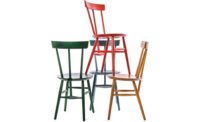Thomas Fletcher, father of five, radiologist, and homeowner of a recently completed 4,200-square-foot house near downtown Austin, is sad. “It’s remorse,” he says of the absence of activity now that construction of his house is complete. “I can’t tell you how much I enjoyed taking part in the realization of this place. I never knew how much I’d miss the process when it was over.” Kevin Alter and Ernesto Cragnolino, principals of Austin-based Alterstudio Architects, deserve the credit for the three-year intellectual exercise that Fletcher had so much fun participating in.
In a neighborhood of early twentieth-century brick chateau-style residences, this house, modern and eye-catching with a base of black Leuders limestone and a broad ipe rain screen at its middle, stands out as what Alter calls “a beautiful object on a hill.” “Despite its four bedrooms, the three-story house is essentially a one-bedroom loft,” says Alter.
The focus may very well be on the top floor, which boasts 270-degree views and which contains the master suite, kitchen, and main living area. But the other two levels have plenty of their own assets. Those moments begin at the street, as you climb a gently rising path of concrete steps before coming to the over-scaled, pivoting glass front door that provides a fluid transition from rough limestone exterior to polished interior. Entering the house you face a stair with large ebonized oak treads hanging in a vertical space that connects all three stories. Past the stair, an etched glass wall reveals moving shadows from a stand of giant bamboo just outside, while a band of clear glass directs attention to a private garden. Rough shards of granite pass through the glass from outside to an interior granite fountain. Up the stairs to the second floor is a formal dining room (complete with catering kitchen and wine cellar), a guest suite at one end, and two bedrooms at the other (at least two of Fletcher’s five children stay with him much of the time). The rooms are well proportioned and have several eye-catching details (a punched window in one, an inverted one in another, built-ins including cabinetry and a bed in the guest suite), but the most notable feature has to be the rain screen. From the dining room, two 10-and-a-half-foot sections of the screen dramatically unfold to reveal some of the amazing views of Austin’s extensive greenbelt and the city beyond “This house is all about looking out,” says Alter, who took pains with the design to downplay the view to the west, with its unsightly power lines and neighboring houses above, and keep the focus on the northern, southern, and eastern views.
Up the stairs again and the third floor delivers the views, enhanced by an uninterrupted ceiling plane in the living area. The edge of the rain screen is apparent, as it rises 18 inches above the floor level “to give you a feeling of safety,” says Alter, “so you don’t feel like you’re going to fall out of the wall-to-ceiling windows.” Those same windows are accentuated by monolithic corner glazing. The west side of the third floor has a strategic pattern of porthole windows to illuminate the interior and contribute to the house’s texture palette with patterns of light and shadow that change through the day.
For Fletcher, who had never before lived in a modern house, living in his new home is wonderful—but not as wonderful as the excitement he felt being involved in its creation. As it evolved, architect and client met every week to discuss all aspects of the project. And while there’s some disagreement over who suggested the cherry picker to demonstrate the importance of building a three-story home, neither Alter nor Fletcher will deny the adrenaline rush they both felt throughout the whole design and construction process. Fletcher experienced so much joy, in fact, that apparently he is ready to put the house on the market and have another one built, with Alter as architect again. “I’m hooked,” he says.

















